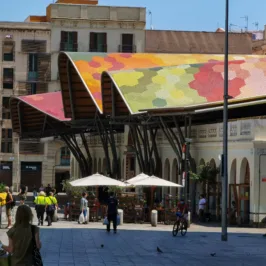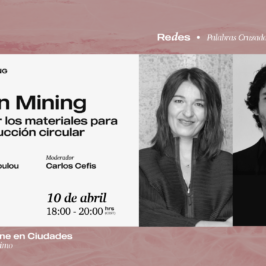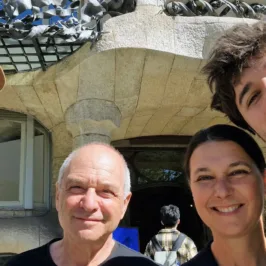HI WALKERS!
Today we share with you an article written by one of our last walkers, following an interview after walking with our Barcelona & Gaudi Walking Tour.
She has a blog, Curating experiences for the design inspired traveller, where she writes about trips around the world and her experience in the different places she visits.
What strikes you most when traveling to a different country? What immediately grabs your attention, causing you to whip out your camera, and snap that amazing shot that will forever have a place on your living room wall?
These are some of the questions that she tries to answer through the different posts in her blog.
It’s a pleasure that Barcelona and the interview made after enjoying a Walking Tour with BAW, have inspired you for such an interesting article.
Here it is for you all!
BARCELONA FOR THE WIN: HOW THE FUTURE OF BARCELONA DESIGN CAN LEVEL UP YOUR TRAVEL EXPERIENCE
My first trip to Barcelona was in the fall of 2016. One might say that travelling in Barcelona during “off season” is deceptive; with the exception of inclement weather, I wouldn’t have guessed it! Hordes of people could be seen lining up from every entrance of major tourist attractions like La Sagrada Familia, Casa Batillo and Parc Guell; while others aimlessly stood around, angling their bodies for that perfect “selfie”. Clear signs that the city was still bustling with tourists.
This situation brought to light the perils of Overtourism which has already affected the city of Venice and prompted lawmakers to take action in Iceland. This topic was further highlighted in a 2017 Skift Travel Megatrends report which suggests that “part of the solution to overcrowding and the negative influences of tourism have been a policy of directing travellers out of hubs and city centres to suburbs and lesser-known neighbourhoods.”
In my inaugural post, I wrote that, experiencing design through travel “frames a better understanding of (…) cultures and helps us set a mental trajectory of new practices and ways of thinking that, once unfolded upon our return to our homelands, forever shapes our identities and perspectives.” Generally speaking, design helps us to travel deeper so that we have more enriching experiences. And while Barcelona city officials may be challenged with the issue of balancing tourist demands with resident concerns, one key initiative that may be a potential win in effecting social change is the concept of Superblocks.

I first heard about this idea of Superblocks in my phone interview with Miguel Angel Borras, owner of Barcelona Architecture Walks. I came across Miguel’s company while doing research for an architecture walking tour prior to my trip. What drew me to this particular company was the fact that all of the tours are led by architects including Miguel who is a partner at the firm MIEL Arquitectos (which translates to HONEY Architects).
On a crisp mid October morning, I ambled towards the meeting point at Passeig de Gracia and Gran Via for the Barcelona and Gaudi tour. Given my short stay (three days), I chose this particular tour because I wanted to learn more about a man who is a hallmark of Barcelona architecture. Led by architect Joan, our group of about 10 individuals traversed throughout the city for about three hours listening to the beginnings of Barcelona as a walled settlement, its expansion as a result of the “Enlightenment” stage and its present day look. Interlaced in these stories was that of Antoni Gaudi and the role he played in shaping Barcelona’s cityscape. We witnessed his works first hand while walking past the exteriors of Casa Vicens, Casa Batllo and La Pedrera.
Months later, I caught up with Miguel on a call to discuss the tour company and Barcelona design. We delved into the company’s start, an idea prompted by a trip to Australia and his participation in Sydney Architecture Walks. As an architect, Miguel was impressed by what he learnt during the tour and knew that the idea had “legs” for successful adoption in Barcelona. One can choose from 5 walking tours, each providing a unique insight into Barcelona architecture from varying angles.
When asked about the design culture in Barcelona, Miguel commented: “it is part of the DNA of the city” – a testament to his other declaration that: “Architecture is a way we use to explain our existence”. Because of this belief, Barcelona Architecture Walks can truly be seen as a medium to espouse not only social awareness but also social change within the city of Barcelona.
Miguel’s musings over Barcelona’s design culture – past, present and future – are poetic yet realistic. His mention of Superblocks and its impact on the future of Barcelona dawns on me as another way in which Barcelona is forging ahead in the use of design to engage and facilitate social change.
You can listen to more of my conversation with Miguel where we chat about the uniqueness of Barcelona design, the juxtaposition of design and travel, and Barcelona Architecture Walk’s role as a Design Ambassador below.

Simply put, a “superblock is a mini-neighborhood created on a grid that confines higher-speed motorized traffic on the perimeter so that the interior roads are freed up for pedestrian-friendly public space.” The general idea has both environmental and social benefits. For the former, reclaiming the use of inner roadways within a superblock for pedestrian purposes creates expanded public spaces which allows for greater access to and better enjoyment of these areas, while also helping to tackle a public health care issue of air pollution. While its implementation has faced some public scrutiny, many agree that “the plan to be widely accepted, (…) will require a cultural shift in the way people view and use the streets.”
So what does this mean specifically for travellers?
An even wider window into the way Barcelona residents live. I strongly believe that from a traveller’s perspective, the implementation of Superblocks would enable a greater depth of cultural immersion as the city’s streets become extensions of their inner homes.
Moreover, with a shift in the average traveller’s mindset for more human centric experiences, a deeper connection is a point of differentiation and what is being sought. I can only surmise that as Barcelona continues to explore various approaches including Superblocks to shaping its cityscape, that a continued focus on its people’s cultures and values will inadvertently draw a stronger interest in those who want to travel deeper.












Leave a Reply